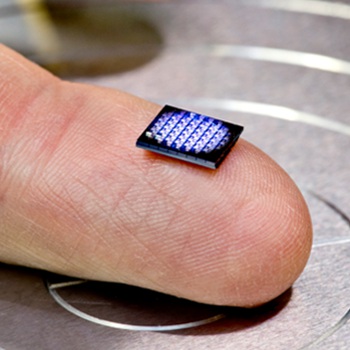 |
| April 03, 2018 | Volume 14 Issue 13 |
Designfax weekly eMagazine
Archives
Partners
Manufacturing Center
Product Spotlight
Modern Applications News
Metalworking Ideas For
Today's Job Shops
Tooling and Production
Strategies for large
metalworking plants
IBM predicts 5 big technology innovations that will reshape how we do business and live
Arvind Krishna, head of IBM Research, introduced IBM's annual "5 in 5" technology predictions on March 19, right before the launch of the company's largest client event of the year, Think 2018, held in Las Vegas. The list aims to highlight some of the biggest breakthroughs coming out of IBM Research's global labs and is pared down to the five technologies the company thinks will fundamentally reshape business and society in the next five years.
What's trending on the horizon? Krishna says:

Cryptographic anchors, such as computers smaller than a grain of salt, will be embedded in everyday objects and devices to provide identification and authentication.
- Crypto-anchors and blockchain will unite against counterfeiters.
Within the next five years, cryptographic anchors -- such as ink dots or tiny computers smaller than a grain of salt -- will be embedded in everyday objects and devices. They'll be used in tandem with blockchain's distributed ledger technology to ensure an object's authenticity from its point of origin to when it reaches the hands of the customer. These technologies pave the way for new solutions that tackle food safety, authenticity of manufactured components, genetically modified products, identification of counterfeit objects, and provenance of luxury goods. - Lattice cryptography will challenge hackers.
IBM is developing encryption methods to keep pace with emerging technologies such as quantum computers, which will someday be able to break all current encryption protocols. IBM researchers have already developed a post-quantum encryption method, which they've submitted to the U.S. government -- called lattice cryptography. No computer can crack it, not even future quantum computers. With lattice cryptography, we can work on a file, or encrypt it, without ever exposing sensitive data to hackers. - Artificial intelligence-powered robot microscopes may save our dirty oceans.
In five years, small, autonomous AI microscopes, networked in the cloud and deployed around the world, will continually monitor in real time the health of one of Earth's most important and threatened resources: water. IBM scientists are working on an approach that uses plankton, which are natural, biological sensors of aquatic health. AI microscopes can be placed in bodies of water to track plankton movement in 3D, in their natural environment, and use this information to predict their behavior and health. This could help in situations like oil spills and runoff from land-based pollution sources, and to predict threats such as red tides. - AI bias will explode, but only the unbiased AI will survive.
Within five years, we will have new solutions to counter a substantial increase in the number of biased AI systems and algorithms. As we work to develop AI systems we can trust, it's critical to develop and train these systems with data that is fair, interpretable, and free of racial, gender, or ideological biases. With this goal in mind, IBM researchers developed a method to reduce the bias that may be present in a training dataset, such that any AI algorithm that later learns from that dataset will perpetuate as little inequity as possible. IBM scientists also devised a way to test AI systems even when the training data is not available. - Quantum computing will be mainstream.
In five years, quantum computing will be used extensively by new categories of professionals and developers to solve problems once considered unsolvable. Quantum will be ubiquitous in university classrooms, and will even be available, to some degree, at the high school level. IBM Researchers are already achieving major quantum chemistry milestones. They successfully simulated atomic bonding in beryllium hydride (BeH2), the most complex molecule ever simulated by a quantum computer. In the future, quantum computers will continue to address problems with ever-increasing complexity, eventually catching up to and surpassing what we can do with classical machines alone.
This year's "5 in 5" is far more than a showcase of groundbreaking innovation. "It's a reaffirmation of technology's role as a force for good in a world that desperately needs it," Krishna says. "Society's ability to overcome intractable challenges and unprecedented threats depends on steady advancements in technologies like AI, blockchain, lattice cryptography, and quantum computing ... powerful systems we can trust that enable us to look with renewed hope to the future."
Source: IBM
Published April 2018
Rate this article
View our terms of use and privacy policy
